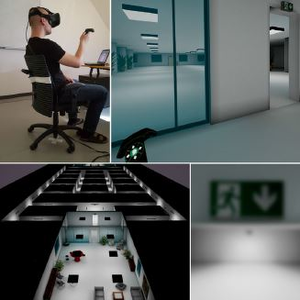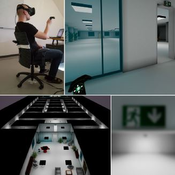Information
- Publication Type: Journal Paper with Conference Talk
- Workgroup(s)/Project(s):
- Date: April 2018
- Journal: The Visual Computer
- Volume: 34
- Open Access: yes
- Number: 6-8
- Location: Bintan, Indonesia
- Lecturer: Katharina Krösl
- ISSN: 0178-2789
- Event: Computer Graphics International (CGI)
- DOI: 10.1007/s00371-018-1517-7
- Conference date: 11. June 2018 – 14. June 2018
- Pages: 911 – 923
Abstract
In workplaces or publicly accessible buildings, escape routes are signposted according to official norms or international standards that specify distances, angles and areas of interest for the positioning of escape-route signs. In homes for the elderly, in which the residents commonly have degraded mobility and suffer from vision impairments caused by age or eye diseases, the specifications of current norms and standards may be insufficient. Quantifying the effect of symptoms of vision impairments like reduced visual acuity on recognition distances is challenging, as it is cumbersome to find a large number of user study participants who suffer from exactly the same form of vision impairments. Hence, we propose a new methodology for such user studies: By conducting a user study in virtual reality (VR), we are able to use participants with normal or corrected sight and simulate vision impairments graphically. The use of standardized medical eyesight tests in VR allows us to calibrate the visual acuity of all our participants to the same level, taking their respective visual acuity into account. Since we primarily focus on homes for the elderly, we accounted for their often limited mobility by implementing a wheelchair simulation for our VR application.Additional Files and Images
Weblinks
BibTeX
@article{Kathi-2018-VRB,
title = "A VR-based user study on the effects of vision impairments
on recognition distances of escape-route signs in buildings",
author = "Katharina Kr\"{o}sl and Dominik Bauer and Michael
Schw\"{a}rzler and Henry Fuchs and Michael Wimmer and Georg
Suter",
year = "2018",
abstract = "In workplaces or publicly accessible buildings, escape
routes are signposted according to official norms or
international standards that specify distances, angles and
areas of interest for the positioning of escape-route signs.
In homes for the elderly, in which the residents commonly
have degraded mobility and suffer from vision impairments
caused by age or eye diseases, the specifications of current
norms and standards may be insufficient. Quantifying the
effect of symptoms of vision impairments like reduced visual
acuity on recognition distances is challenging, as it is
cumbersome to find a large number of user study participants
who suffer from exactly the same form of vision impairments.
Hence, we propose a new methodology for such user studies:
By conducting a user study in virtual reality (VR), we are
able to use participants with normal or corrected sight and
simulate vision impairments graphically. The use of
standardized medical eyesight tests in VR allows us to
calibrate the visual acuity of all our participants to the
same level, taking their respective visual acuity into
account. Since we primarily focus on homes for the elderly,
we accounted for their often limited mobility by
implementing a wheelchair simulation for our VR application.",
month = apr,
journal = "The Visual Computer",
volume = "34",
number = "6-8",
issn = "0178-2789",
doi = "10.1007/s00371-018-1517-7",
pages = "911--923",
URL = "https://www.cg.tuwien.ac.at/research/publications/2018/Kathi-2018-VRB/",
}


 Paper
Paper
